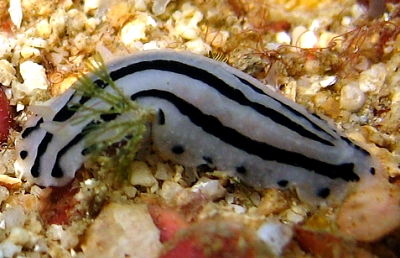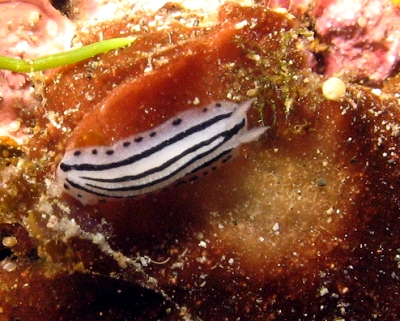Variant of Phyllidiopsis striata from Indian Ocean
June 14, 2007
From: Hugues and Sandrine Flodrops

Dear Bill,
To accompany my message about typical Phyllidiopsis striata [#19311 ].
Here are photos of two others which seem to be a bit different - like the photo of Marina Poddubetskaia (message #8318 ).
We have observed on three specimens that the two external black lines aren't connected at the posterior end. Is it a variation or a juvenile characteristic?
The first specimen [upper photo ] was taken in Mauritius, 20 november 2006, Place: Ilot Tamarin, Town: Flic and Flac, Depth 15 metres, size:about 5 mm.
The second specimen [lower photo] was taken in Reunion, date observed: 16 january 2007, place "Sec Jaune", Town: Saint-Leu, Depth 18 metres, size about 6-7mm. Photographer: Hugues Flodrops
Thanks for your thought.
Best regards.
Hugues and Sandrine.
hugues.flodrops@wanadoo.fr
Flodrops,H.S., 2007 (Jun 14) Variant of Phyllidiopsis striata from Indian Ocean. [Message in] Sea Slug Forum. Australian Museum, Sydney. Available from http://www.seaslugforum.net/find/19312
Dear Hugues and Sandrine,
Thanks for these photos. I suspect we still have some more to learn about this group of phyllidiids. Certainly in typical P. striata the outer black lines join posteriorly and sometimes anteriorly as well. The same is the case with P. annae, which can also have black spots around the mantle edge. The difference between these two species is that P. annae has black rhinophores while P. striata has white or rather, colourless rhinophores. What they have in common is three longitudinal ridges separating the 4 black lines. Phyllidiopsis phiphiensis looks quite like your photos here, but it differs in having only two longitudinal ridges.
But our knowledge of these species is based mainly on a very few preserved specimens so it's possible we have it wrong. Perhaps the colour of the rhinophores is variable, or the number of ridges? I guess the only thing I can say is keep looking for variablity and for behavioural clues. Perhaps you will find two colour forms mating, or perhaps different colour forms feeding on different sponges or laying different egg ribbons.
Best wishes,
Bill Rudman
Related messages
-
Typical Phyllidiopsis striata from Reunion Island
From: Hugues & Sandrine Flodrops, June 14, 2007 -
Phyllidiopsis phiphiensis or P. striata?
From: Kee Alfian B. Abdul Adzis, February 8, 2006 -
Phyllidiopsis striata from Palawan, Philippines
From: Michael Jimenez, June 13, 2005 -
Phyllidiopsis striata from South Africa
From: Colin Ogden, June 7, 2005 -
Re: Blue 'sponge' from Reunion
From: Marina Poddubetskaia , November 9, 2002 -
Phyllidiopsis striata from Reunion
From: Marina Poddubetskaia, November 7, 2002 -
Phyllidiopsis striata from west Malaysia
From: Kheong Sann Chan, June 20, 2002 -
Tonga Records: Phyllidiopsis striata
From: Don Barclay, May 29, 2001 -
Phyllidiopsis striata from Lady Musgrave Isl.
From: David Harasti, February 10, 2001 -
Phyllidiopsis striata from South Africa
From: Valda Fraser, August 23, 2000 -
Partly yellow Phyllidiopsis striata? from Thailand
From: N. Sittithaweepat, April 8, 2000 -
Phyllidiopsis striata from the Maldives
From: Erwin Koehler, August 2, 1999
